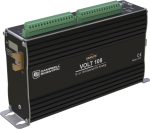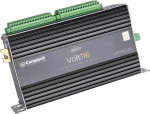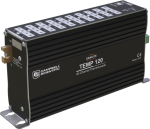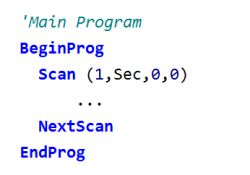Overview
El todo nuevo Datalogger CR6 será un núcleo importante para su sistema de adquisición de datos. Hemos combinado las mejores destrezas de todos nuestros dataloggers para llevarle a usted un equipo de alto rendimiento. Comunicación veloz, bajo requerimiento de energía, USB integrado, y conexiones desmontables son algunas de las nuevas y mejoradas características del poderoso CR6. El CR6 introduce la nueva terminal universal (U) una ingeniosa forma de virtualmente recibir cualquier sensor análogo, digital o inteligente. Además es nuestro primer Datalogger que permite recibir directamente sensores de cuerda vibrante para mediciones estáticas.
Read MoreBenefits and Features
- All-in-one edge device and gateway with built-in connectivity
- Native vibrating wire measurements using VSPECT
- Integrated communication options, charge regulator, and expandable storage to provide simplicity and reduced costs
- Configurable Universal (U) measurement and control terminals to measure virtually any sensor or application
- Availability of Campbell Scientific qualified support staff
- Designed and manufactured for long-term operation in extreme environments
Images







Similar Products
Detailed Description
The CR6 is the only monitoring platform currently available that operates as an edge device and gateway with connectivity, provides an industry standard for rugged design, has universal sensor compatibility and communication options, and includes VSPECT for vibrating wire measurements.
Edge and Gateway Device
The variability and site-specific challenges and constraints that exist in robust monitoring networks typically result in a wide array of devices to achieve full functionality. With built-in and modular measurement, processing, control, and communication capabilities, the CR6 is the only device that is needed.
As a gateway device, the CR6 converts the data measured into the format or protocol required to seamlessly communicate on your network—whether on your computer or the cloud. Entry into the network does not require a separate edge device, as the CR6 also fills this role. Additionally, the CR6 forms a network as a connectivity device via spread-spectrum radio, Wi-Fi, serial, and RS-485.
Using the CR6 as an edge device and gateway with connectivity allows you to standardize on a single platform in your monitoring program. This simplifies purchasing, inventory management, and an overall required knowledge base. The CR6 is capable of a wide range of over thirty-five M2M protocols that include PakBus, MQTT, DNP3, IPv4, IPv6, HTTP/HTTPS, and PPP. Connectivity options include cellular, radio, satellite, Ethernet, and Wi-Fi. These communication methods enable access to critical data and the ability to receive alarms triggered by user-configured thresholds and events.
Native Vibrating Wire Using VSPECT
VSPECT, Campbell Scientific’s patented technology for measuring vibrating wire sensors, significantly improves vibrating wire sensor measurements—regardless of the manufacturer of the sensor. For more details about this unique technology visit our VSPECT® Essentials web resource.
Integrated Benefits for Simplicity and Reduced Costs
The integrated benefits and capabilities of the CR6 make it the most flexible platform available. In addition to several spread-spectrum radio options that are compatible with available frequencies across the world, it also includes Wi-Fi, Ethernet, and compatibility with modular cellular and satellite modems. Using Campbell Scientific communication peripherals ensures complete compatibility and extremely low power consumption.
The built-in charge regulator, with direct connections for main power or solar panels, is used to keep your battery charged. An intelligently designed and maintained power supply ensures long-term functionality and helps to capture data from critical events when you need it.
With regular data collection intervals or remote access, the 4 MB of onboard CR6 memory will likely be sufficient. However, if your application requires high measurement frequency; long, unattended deployments; or data storage redundancy, the CR6 has built-in expandable memory via a microSD card.
Communication Options
The CR6 Automated Monitoring Platform is available in different integrated communications frequency radio options.
CR6-WIFI
The CR6-WIFI comes factory-configured as a Wi-Fi access point. Alternatively, the CR6-WIFI can be configured to join an existing Wi-Fi network with standard or Enterprise (EAP) security.
CR6-RF407
This 900 MHz, 250 mW, frequency-hopping spread-spectrum radio option can join a high-speed “mesh topology” radio network of other CR6s, ideal for medium-range, license-free radio communications.
CR6-RF412
Designed primarily for unlicensed operation in Australia and New Zealand, this 922 GHz, 250 mW, frequency-hopping spread-spectrum radio can join a high-speed “mesh topology” radio network of other CR6s and is also ideal for medium-range, license-free radio communications.
CR6-RF422
Used in the UK and EU and ideal for short- to medium-range, license-free radio communications, this 868 MHz, 25 mW option includes listen-before-talk (LBT) and adaptive-frequency-agility (AFA). It can join a high-speed “mesh topology” radio network of other CR6s using the included RF422 radio.
CR6-RF452
With this internal 900 MHz, 1 W, frequency-hopping spread-spectrum radio option, the CR6-RF452 can be part of a “star topology” network where all radio-frequency (RF) traffic routes back through the gateway. This option is ideal for long-range, license-free radio communications.
Universal Measurement and Control Terminals
The Universal or “U” terminals allow each terminal to be configured to measure a multitude of different types of sensor outputs. This allows the CR6 to be used in many different applications, regardless of the sensor types required—analog, digital, smart, or vibrating wire. This nearly limitless array of sensors includes inclinometers, meteorologic, hydrologic, piezometers, water quality, etc. The flexibility of Universal channels allows you to standardize on a single monitoring platform for all projects.
Support Staff
Recognized for more than 45 years for our outstanding customer support, Campbell Scientific includes experienced product engineering teams, knowledgeable technical support, attentive sales staff, and market-focused professionals who are committed to ensuring your success throughout the lifetime of your project.
Rugged Design
Unique to all CR6 Automated Monitoring Platforms is the design and manufacturing process used to ensure operational integrity in the most extreme environments. Each CR6:
- Includes surge electrostatic discharge (ESD) and over voltage protection, as well as dust protection.
- Is fully tested for shock and vibration tolerance.
- Is factory chamber tested for its full operational temperature range (standard range -40° to +70°C and extended range -55° to +85°C).
- Has been proven in hundreds of real-world applications.
These extreme measures are required to manufacture a product with a meantime between failure (MTBF) of 557 years! This means that if you purchase a CR6 today, your probability of failures during the warranty period (three years) is 0.6%. The CR6 Automated Monitoring Platform will last the entirety of your project, even if that means decades.
Compatibility
Please note: The following shows notable compatibility information. It is not a comprehensive list of all compatible products.
Software
| Product | Compatible | Note |
|---|---|---|
| DevConfig | (Version 2.10 or higher) | |
| LoggerLink | (Version 1.3 or higher) | |
| LoggerNet | (Version 4.3 or higher) | |
| PC400 | (Version 4.3 or higher) | |
| RTDAQ | (Version 1.2 or higher) | |
| Short Cut | (Version 3.1 or higher) |
Additional Compatibility Information
Sensores
El CR6 tiene 12 terminales U y 4 terminales C que son programables para una gran variedad de funciones. Esto permite que el CR6 mida virtualmente cualquier sensor existente, incluyendo voltaje, puentes de Resistencia, cuerda vibrante estática, pulsos, cierres de interruptor, SDI-12 y serial RS-232/RS485.
Periféricos de control y medición
El CR6 incluye una interface que le permite conectarse a nuestros dispositivos CDM (interface SC-CPI no es necesaria) El CR6 también es compatible con todos los periféricos actuales como multiplexor, SDMs, módulos de entrada de terminal y relays.
Comunicaciones
El CR6 tiene un Puerto 10/100baseT para comunicación Ethernet, un Puerto USB para comunicación con la PC, una ranura para tarjetas tipo microSD. Es compatible con los módems tipo multidrop, módems de corto alcance (short-haul), módems de línea fija, celular o sintetizador de voz. Telemetría RF y transmisiones satelitales, (Argos, GOES y Meteosat). Los datos se pueden ver con el teclado CR1000KD, el display CD100 o con dispositivos iOS o Android (requiere Loggerlink)
Gabinetes
El CR6 y su fuente de poder pueden ser almacenados en cualquiera de nuestros gabinetes disponibles.
Energía
EL CR6 utiliza una fuente de poder externa, además tiene una regulador/cargador incluido. La fuente de poder inteligente incluida escoge la fuente de poder con mejor energía, ya sea batería, panel solar o USB para operar en alguno de los siguientes modos:
- UPS (recomendado) – Un panel solar de 20 Watts o una fuente de poder DC desde 16 a 32 Vdc para cargar la bacteria de 12Vdc como una BP7, BP12 o BP24.
- Batería de 12 Vdc u otra fuente confiable de 12Vdc
- Cargador únicamente – Fuente de poder 16 a 32 Vdc
- USB – energizado a 5 Vdc a través del Puerto USB para setup, programación y pruebas (no carga baterías, energiza los puertos de 12V o SW12)
Software
El CRBasic es el software para la completa programación del CR6. Soporta tanto programación simple como compleja y administración de datos en línea para reducción de procesos.
Software Compatible:
- LoggerNet (versión 4.3 o mayor)
- DevConfig (versión 2.10 o mayor)
- PC400 (versión 4.3 o mayor)
- PC200W (versión 4.3 o mayor)
- Short Cut (versión 3.1 o mayor)
- CRBasic (versión 3.5 o mayor)
- Loggerlink (versión 1.3 o mayor)
- RTDAQ (versión 1.2 o mayor)
- LNDB (versión 1.2 o mayor)
Specifications
| -NOTE- |
|
| Operating Temperature Range |
|
| Maximum Scan Rate | 1000 Hz |
| Case Material | High-impact-resistant polycarbonate and UV-resistant TPE, recycle code 7 |
| Analog Inputs | Up to 12 single-ended or 6 differential (The CR6 has 12 universal [U] and 4 control [C] terminals that can be programmed for a variety of functions. The number of analog inputs, switched excitations, and digital ports assume all the ports are configured the same.) |
| Universal Inputs | 12 individually configured inputs for analog or digital functions |
| Pulse Counters | 16 (C1 to C4 and U1 to U12) |
| Communications Ports |
|
| Data Storage Ports | microSD |
| Switched 12 Volt | 2 terminals |
| Digital I/O | 16 terminals (C1 to C4, U1 to U12) configurable for digital input and output. Terminals are configurable in pairs for 5 V or 3.3 V logic for some functions. |
| Input Limits | ±5 V |
| Analog Voltage Accuracy |
|
| ADC | 24-bit |
| Charge Terminal Characteristics (CHG+ and CHG-) |
|
| Battery Terminal Characteristics (BAT+ and BAT-) |
|
| Real-Time Clock Accuracy | ±3 min. per year (optional GPS correction to ±10 µs) |
| Internet Protocols | Ethernet, PPP, RNDIS, ICMP/Ping, Auto-IP (APIPA), IPv4, IPv6, UDP, TCP, TLS (v1.2), DNS, DHCP, SLAAC, Telnet, HTTP(S), SFTP, FTP(S), POP3/TLS, NTP, SMTP/TLS, SNMPv3, CS I/O IP, MQTT |
| Communications Protocols | CPI, PakBus, SDM, SDI-12, Modbus, TCP, DNP3, UDP, NTCIP, NMEA 0183, I2C, SPI, and others |
| Battery-backed SRAM for CPU Usage & Final Storage | 4 MB |
| Data Storage | 4 MB SRAM + 72 MB flash (Storage expansion of up to 16 GB with removable microSD flash memory card.) |
| Idle Current Drain, Average |
|
| Active Current Drain, Average |
|
| Static Vibrating Wire Measurements | Supported |
| Dimensions |
21.0 x 10.2 x 5.6 cm (8.3 x 4.0 x 2.2 in.) Additional clearance required for cables and leads. |
| Weight | 0.42 to 0.52 kg (0.92 to 1.15 lb) depending on communication option selected |
CR6-RF407 Option |
|
| Radio Type | Frequency Hopping Spread Spectrum (FHSS) |
| Output Power | 5 to 250 mW (user-selectable) |
| Frequency | 902 to 928 MHz (US, Canada) |
| RF Data Rate | 200 kbps |
| Receive Sensitivity | -101 dBm |
| Antenna Connector | RPSMA (External antenna required; see www.campbellsci.com/order/rf407 for Campbell Scientific antennas.) |
| Idle Current Drain, Average | 12 mA (@ 12 Vdc) |
| Active Current Drain, Average | < 80 mA (@ 12 Vdc) |
CR6-RF412 Option |
|
| Radio Type | Frequency Hopping Spread Spectrum (FHSS) |
| Output Power | 5 to 250 mW (user-selectable) |
| Frequency | 915 to 928 MHz (Australia, New Zealand) |
| RF Data Rate | 200 kbps |
| Receive Sensitivity | -101 dBm |
| Antenna Connector | RPSMA (External antenna required; see www.campbellsci.com/order/rf412 for Campbell Scientific antennas.) |
| Idle Current Drain, Average | 12 mA (@ 12 Vdc) |
| Active Current Drain, Average | < 80 mA (@ 12 Vdc) |
CR6-RF422 Option |
|
| Radio Type | 868 MHz SRD 860 with listen-before-talk (LBT) and adaptive-frequency-agility (AFA) |
| Output Power | 2 to 25 mW (user-selectable) |
| Frequency | 863 to 870 MHz (UK and EU) |
| RF Data Rate | 10 kbps |
| Receive Sensitivity | -106 dBm |
| Antenna Connector | RPSMA (External antenna required; see www.campbellsci.com/order/rf422 for Campbell Scientific antennas.) |
| Idle Current Drain, Average | 9.5 mA |
| Active Current Drain, Average | 20 mA |
CR6-RF427 Option |
|
| Radio Type | Frequency Hopping Spread Spectrum (FHSS) |
| Output Power | 5 to 250 mW (user-selectable) |
| Frequency | 902 to 907.5 MHz/915 to 928 MHz (Brazil) |
| RF Data Rate | 200 kbps |
| Receive Sensitivity | –101 dBm |
| Antenna Connector | RPSMA (External antenna required.) |
| Idle Current Drain, Average | 12 mA (@ 12 Vdc) |
| Active Current Drain, Average | < 80 mA (@ 12 Vdc) |
CR6-RF452 Option |
|
| Radio Type | Frequency Hopping Spread Spectrum (FHSS) |
| Output Power | 10 to 1,000 mW (user-selectable) |
| Frequency | 902 to 928 MHz |
| RF Data Rate | 115.2 or 153.6 kbps (selectable speeds) |
| Receiver Sensitivity |
|
| RF Connector | Reverse Polarity SMA (RPSMA) jack (external antenna required) |
| Idle Current Drain, Average | 15 mA (@ 12 Vdc) |
| Active Current Drain, Average | 650 mA (@ 12 Vdc) |
CR6-WIFI Option |
|
| Operational Modes | Client or Access Point |
| Operating Frequency | 2.4 GHz, 20 MHz bandwidth |
| Antenna Connector | RPSMA |
| Antenna | pn 16005 unity gain (0 dBd), 1/2 wave whip, omnidirectional with articulating knuckle joint for vertical or horizontal orientation |
| Transmit Power | 7 to 18 dBm (5 to 63 mW) |
Documents
Videos & Tutorials
Downloads
CR6 Web Browser Interface v.1.2 (801 KB) 13-09-2024
Standard Datalogger Web Browser Interface
Use this download to update the dataloggers web browser interface.
To install this file, send it to the datalogger using file control found in the Device Configuration Utility or file control found in LoggerNet.
This interface is recommended for fast IP interfaces like Ethernet and WiFi. It does NOT perform well over slow communications mediums like cellular.
Note: This is NOT for system dataloggers that have custom interfaces like the SunSentry, Hydro-Link, Alert205, and MeteoPV.
CR6 RF45x OS Update v.4.01 (438 KB) 19-11-2024
This CR6-RF45x Series OS update is for the following:
- CR6-RF451
- CR6-RF452
Use the Device Configuration Utility to perform this update.
Device Configuration Utility v.2.33 (49.6 MB) 07-07-2025
A software utility used to download operating systems and set up Campbell Scientific hardware. Also will update PakBus Graph and the Network Planner if they have been installed previously by another Campbell Scientific software package.
Supported Operating Systems:
Windows 11 or 10 (Both 32 and 64 bit)
CR6 RF407 Series OS Update v.2.0 (430 KB) 03-07-2019
This CR6-RF407 Series OS update is for the following:
- CR6-RF407
- CR6-RF412
- CR6-RF422
- CR6-RF427
Use the Device Configuration Utility to perform this update.
Note: This is not for the CR6-RF451.
CR6 Wifi OS Update v.5.03 (2.23 MB) 21-05-2021
CR6 Wi-Fi OS update. This download includes the OS and the update procedure.
Custom Menu Example Program for Connections Video v.1 (1 KB) 26-03-2024
This program demonstrates creating a custom menu for data logger displays and corresponds to the Campbell Connections video: Creating Custom Menus in CRBasic for a Data Logger Display.
Data Logger Wiring Excel Template (1 KB) 26-03-2024
This is a data logger wiring diagram spreadsheet template that accompanies the Wiring Diagram Video. The spreadsheet includes templates for CR6, CR1000X, CR300, CR310, and CR350 data loggers. The file is an Excel template and works best with Microsoft Excel.
Frequently Asked Questions
Number of FAQs related to CR6: 5
Expand AllCollapse All
-
If a CPI-enabled device is running and there are skipped scans in the data logger, what can be done?
The default CPI bus speed setting is 250 kB/s. The speed is adjustable in your CRBasic data logger program. Use the CPISpeed() instruction in your CRBasic program to adjust the CPI bus bandwidth to meet the following maximum combined (total) Ethernet cable lengths:
- 1000 kB/s for maximum combined Ethernet cable lengths of 15.2 m (50.0 ft)
- 500 kB/s for maximum combined Ethernet cable lengths of 61.0 m (200.0 ft)
- 250 kB/s for maximum combined Ethernet cable lengths of 152.4 m (500.0 ft)
-
The potential transformer and the current transformer provide differential outputs that have galvanic isolation from the voltage and current in the circuit they are measuring. However, there is no need to run the outputs of these transformers into differential inputs of the data logger and unnecessarily consume additional data logger channels. We conducted extensive testing for noise immunity, for inaccuracies from ground loops, and more before concluding that single-ended measurements in the ACPower() instruction have the same performance as differential measurements would provide. Please note that as a result of the galvanic isolation of the potential transformer and current transformer, the data logger ground is NOT connected to the ground of the circuit they are measuring.
Said differently, you can connect differential outputs of a sensor to single-ended inputs of the data logger. However, doing so creates the possibility of poor common-mode noise rejection in the data logger and the possibility of introducing inaccuracies from ground loops between the sensor and the data logger. Note that in this application, the transformer isolation of the potential transformer and the current transformer eliminates these concerns.
Simply connect one of the potential transformer secondary wires and one of the current transformer secondary wires to the data logger ground. Which wire in either case makes a difference, as the phase information allows the measurement of power flowing in either direction. If you measure negative real power when it should be positive, then reverse the secondary wires of the potential transformer where they connect to the data logger. Alternatively, you can reverse the secondary wires on the current transformer, but don't reverse both pairs of wires.
-
When idle, the CR1000, CR6, and CR1000X consume less than 1 mA @ 12Vdc. Similar to the CR6, the CR1000X has a much faster processor that requires more power when up and running. As such, there will be higher current draws during active measurements, serial communications, or when plugged into a PC via USB or Ethernet.
It may be helpful to think of the CR6 and CR1000X as being built on the same "platform."
-
A practical maximum is to connect one multiplexer per every two control terminals on the data logger. Control terminals can be shared between multiplexers to increase the number of connected multiplexers. Sharing terminals, however, requires more complex wiring and programming. Users who would like to connect more than one multiplexer per every two control terminals are advised to contact a sales or support engineer at Campbell Scientific for assistance.
Casos de estudio
In the mountains of Antioquia, Colombia, eight of the region’s most important dams now share......read more
Overview The Udhampur-Srinagar-Baramulla Rail Link (USBRL) project is of national importance as it connects Kashmir to the......read more
The Expressway S19 represents a critical link in Europe’s transportation network, stretching 570 km (354.2......read more
Understanding the spatial variability of the Earth’s atmospheric boundary layer—including the surface layer near the......read more
Overview The reconstruction of the navigational lock system at the Iron Gate I Hydroelectric Power Station......read more
The Homestake Neutrino Experiment—also referred to as the “Davis Experiment” after physicist Ray Davis, who......read more
In the intricacies of transportation networks, bridges take center stage, knitting together communities and ensuring......read more



























































































